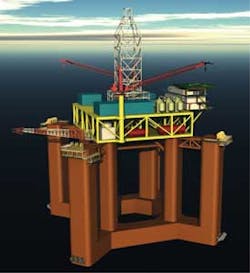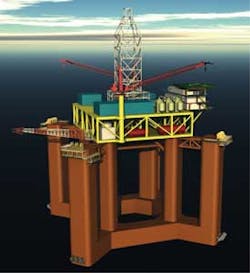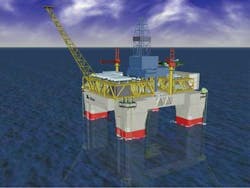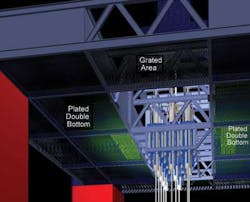Dry trees offer alternative for deepwater development
Ming-Yao Lee
Chevron Energy Technology Co.
Philip Poll
Houston Offshore Engineering
Jack Zeng
Kvaerner
Recent discoveries of several ultra-deepwater fields in the Gulf of Mexico (GoM) are facing challenges to commercial development of reservoirs that include subsalt, drilling/completion, and well intervention complexities. To address these issues, operators have been keen to look for a safe, reliable and cost-effective dry-tree option to increase recovery and reduce subsea well intervention cost.
In many cases, the depth of the reservoir demands large drilling rig and payload, thus resulting in the need for more deck space and heavy topsides. Traditionally, GoM dry-tree solutions have been dominated by spars and TLPs in water depths below 5,000 ft. For water depths beyond about 6,000 ft, a TLP becomes cost prohibitive. For large payload systems, especially those requiring large drilling payload, the size of a spar introduces substantial challenges for construction, transportation and installation, in addition to its requirement of offshore integration of the topsides with hull.
There is a clear business case to identify, select, and qualify technologies to enable ultra-deepwater field developments using a non-spar dry-tree floater (e.g. semisubmersible) with moderate-to-large drilling and production capabilities.
Ongoing industry efforts in maturing dry tree semisubmersible designs that are cost competitive with spars have resulted in two promising hull forms, with associated riser tensioning systems. These designs are expected to overcome the size limitations usually encountered on a spar, and to spur development of dry-tree host alternatives for the ultra deepwater GoM.
Semisubmersible platforms
As the offshore oil and gas development moves to the ultra-deepwater GoM, the use of semisubmersible (semi) platforms has become increasingly popular due to its ability to carry large topsides, with the possibility for quayside integration. Na Kika, Thunder Horse, Atlantis, Independence Hub, and Blind Faith all operate in water depths of more than 6,000 ft. The giant Jack and St. Malo semi floating production facility will soon join the list.
While the wet-tree semi platform has become an operator favorite, its dry-tree counterpart has also received plenty of R&D attention in recent years. The business incentive to develop dry-tree semi platforms is driven by the need for an economical field development solution that can overcome drilling and completion challenges associated with the newly discovered Lower Tertiary Wilcox trend reservoirs in the deepwater GoM. This is especially true for marginal fields in ultra-deepwaters, for which increasing recovery rates and reducing subsea intervention costs enable commercialization.
In deeper waters, the available platform concepts are limited for dry tree developments due to water depth limit on TLPs and payload limits on spars. For water depths beyond about 6,000 ft and large payload systems, especially those requiring a large drilling rig and variable deck load, the semisubmersible becomes a practical dry tree concept alternative that can carry a large well array and topsides and with the capability of quayside topsides installation and integration. It is expected that the dry tree semisubmersible will be cost competitive with the spar in most cases, and overcome the size limitations on the spar in other cases.
Industry collaboration
Over the last decade, the industry has shown significant interest in developing a dry-tree semi solution to increase contracting options for deepwater developments. Much of the published dry-tree semi efforts to date have been concentrated on alternative hull forms including use of damper plates, and some non-conventional geometric measures such as extreme draft or column configurations. However, there remains an uncertainty about the total system maturity, constructability, performance, and cost efficiency. Identified technical challenges associated with the dry tree semi concepts include:
- Hull motions to accommodate proven top tensioned riser systems
- Large payload to meet increased water depth and challenged reservoir conditions
- Constructability of new hull forms and/or other critical components (e.g. well bay layout and hull/riser interfaces)
- Draft limitations required to facilitate quayside integration
- Qualification of new technologies (e.g. long stroke riser tensioning system).
With funding through RPSEA, DeepStar initiated an industry study effort in 2008 to develop a dry-tree concept that can be cost competitive with the spar. The objective of this study project is to define the potential for developing a dry-tree semisubmersible or similar, as a feasible and competitive floater solution for the GoM in 8,000-ft water depth with moderate to large payloads.
The study explored use of conventional technologies to the extent possible, such as hull form, riser hull interface, tensioning options, riser configurations, and riser materials. Future work to address technical gaps and/or limitations has also been identified.
A two-stage approach with clear deliverable milestones was implemented to select and evaluate feasible concepts, followed by a thorough technology readiness review. Two industry workshops have been conducted between stages to evaluate the stage gate deliverables, and the paired-column dry tree semi concept developed by Houston Offshore Engineering (HOE) was selected.
A second industry effort to develop the dry-tree concept was also undertaken by the DeepStar consortium in 2010. The DeepStar project selected the Aker concept, jointly developed by Aker Solutions and Kvaerner, to re-investigate a more "conventional" hull form to determine if it is feasible to combine a typical deep-draft semi with longer stroke tensioners.
Like the HOE paired-column concept, the Aker concept has its pros and cons. The ultra-deep draft required of the HOE concept will limit construction and integration options and may require yard modifications prior to construction. Because the tensioners are field proven, the well bay arrangement is expected to be no more onerous than that of a spar. The Aker concept, on the other hand, opens up the fabrication/integration options due to its shallower draft. However, the use of long-stroke tensioners makes well bay arrangement more difficult.
In early 2011, DeepStar continued the efforts to engage DNV to perform a systematic technology qualification study for the two semi concepts previously studied by RPSEA and DeepStar. The purpose was to identify failure modes, mechanisms, and criticality on the critical and novel design elements of the HOE and Aker dry-tree concepts, rank their associated risks, and discuss mitigations and improvements for future implementation. A study report has been prepared that outlined the preliminary technology qualification plans focusing on the hull and riser interface and other engineering needs.
HOE paired-column semi
The Paired-Column Semi (PC Semi) originally targeted dry-tree applications in the GoM as an alternative to the spar concept for water depth beyond 5,000 ft. It was configured to support quayside integration, traditional structural components, no jacking mechanisms or moving components, and riser tensioning equipment with the same range of stroke as the spar. The column pairs attempt to address the challenges and sometimes conflicting design requirements of a traditional semisubmersible, which include:
- Wide column spacing for stability requirements
- Narrow column spacing for deck support
- Heave natural period and pontoon width
- Shallow pre-service draft for quayside integration
- Deep draft for minimum motions on location.
The column pairs effectively decouple the conflicting design requirements to allow optimum structural support for the deck, optimum column spacing for pre-service and in-place stability, and the desired heave natural period and pontoon width. Improvements to the system include increased deck structural efficiency, a structurally robust hull/deck interface, reduced heave motions and future expandability.
Hull and riser interface
The PC Semi will support top-tensioned risers (TTRs) or steel catenary risers (SCRs). For dry tree applications, TTRs interface with the platform using conventional hydro-pneumatic riser tensioners in the same way that TTRs are supported for TLPs and spars. The tensioner allows relative motion between the top of the riser and the platform through acceptable riser stroke. The primary objective in the original PC Semi development was to configure a hull form compatible with existing riser tensioning equipment. Existing tensioners with a stroke range of 25 to 28 ft are perceived to be suitable for the PC Semi in the GoM environment.
The riser tensioning equipment is supported by a truss structure that spans the inner columns. Again, the paired-column arrangement reduces the span for the upper column frame supporting the high TTR load. A typical dry tree production riser for ultra-deepwater may require a hang-off tension on the order of 1,000 st. The design used here has a total TTR payload of 11,000 st. In the PC Semi, the upper column frame connecting the inboard columns provides a direct load path for one of the most significant loads on the platform.
The TTR interface includes an optional keel guide, which could minimize bending load on the tensioner equipment. The TTRs are arranged as a rectangular pattern of slots at the center of the platform. For the configuration discussed here, the well bay was arranged as 3 rows of 6 slots for a total of 18 slots.
For SCRs, the hull interface is conventional and takes the form of riser porches supported at the pontoon structure. However, for the PC Semi, the pontoon structure connects the inboard columns. This structural arrangement results in SCR porches that are closer to the center of rotation of the platform. The SCR interface at the porch can use a stress joint or flex element, which is typical for spars, TLPs, and semis in the GoM.
Technology readiness
To assess technical readiness, the PC Semi got several technology reviews:
- Review with BOEMRE (then MMS) and USCG in September 2009
- RPSEA Technology Readiness Review Workshop by industry participants in March 2010
- DNV Technology Assessment in March 2011.
There were a few common issues identified in both the RPSEA Technology Readiness Review Workshop and the DNV Technology Assessment. In particular, further engineering and/or qualification required on the vortex induced motion (VIM) response and riser tensioning system verification for a drilling and production semi platform.
VIM response has been raised as a general concern for deep draft semisubmersibles. As the draft increases and longer portions of the hull columns are exposed to currents, the possibility increases for a regular vortex shedding pattern to develop in certain current conditions. Although the paired-column arrangement is different compared to having a single column in each corner, the VIM response cannot be fully verified without specific testing.
Aker dry tree semi
The Aker Dry Tree Semi (Aker DTS) is configured based on a conventional deep draft semisubmersible with four columns and a ring pontoon hull, and an array of RAM-style tensioners to support TTRs during drilling and production. All critical structural and control components proposed for use on Aker DTS have been developed and served in offshore operations for years.
The Aker DTS deck is a modularized design supported on a deck-box type structure with overall dimensions of 350 ft x 252 ft. The topside arrangement is generally divided into three areas, with process in the north, utility in the south and a well bay of 110 x 64 ft in the middle accommodating production and riser systems. Some process and utility equipment is located on the lower deck inside the deck box. Living quarters are set on south end of the deck.
For an optimal solution in the severest GoM environment, the Aker DTS requires compensation of riser stroke in the range of 35 ft, which indicates a moderate increment of 7 to 8 ft in tensioner stroke capacity compared to other dry tree units presently in service. Similar riser tensioning systems have been used onboard drilling rigs with tensioner stroke capacities up to 65 ft. A 35-ft riser tensioner stroke is therefore considered feasible and well within the industry capability in terms of design, fabrication, and operation. The challenge is how to arrange these riser tensioning systems in a practical and safe manner inside the well bay with all satisfactory functional requirements for riser installation, BOP and christmas tree handling, and drilling/work over operations.
Hull and riser interface
Similar to that of PC Semi, Aker DTS also proposed hydro-pneumatic riser tensioners for the TTRs that are supported by the topside deck structures in well bay area. For the examples studied here, well slots are spaced nominally at 16 ft center-to-center on the perimeter of a 3 x 5 grid. The central slot is dedicated to drilling. Lay down areas adjacent to the drilling slot are accessible by cranes. Fluids are transferred via flexible hoses from the trees to the two production manifolds to the south and north. The manifolds run full length in the EW direction of the well bay. Riser tensioning system air pressure vessels (APVs) are arranged adjacent to the manifolds.
The tensioning system uses a cassette-type RAM cylinder arrangement, which is landed and supported by the double bottom top deck. The proposed system will ensure that the production trees/BOP will always be inside the deck box protected well bay area. The tensioner cylinders, accumulators, and centralizer tube will extend below the deck box. A guide structure under the deck box accommodates the lower tensioner centralizer roller assemblies, and transfers any lateral loads into the deck box structure. The structure also acts to shield wave direct impact on the tensioners under extreme and survival wave conditions.
To simplify the riser tensioner design and ensure its functional reliability, a riser guide structural frame is introduced at the pontoon level of the Aker DTS. This is designed to eliminate excessive bending moment on the tensioner cylinders due to platform offset and rotation. The riser guides are supported off the two main truss rows spanning between the east and west pontoons.
The riser tensioning system is also designed so that if a cylinder failure should occur, one cylinder assembly can be replaced with the rest of the tensioning system in full operation. To optimize global performance of the floating system and avoid heave resonance effects near the peak period of a governing design storm, the riser tensioning system utilizes a relative soft stiffness of 17 kips/ft at nominal position. This nominal stiffness is maintained in a very small variation within the entire riser stroke range.
Compared to a well bay design onboard a TLP or spar, the Aker DTS well bay is spaced out both vertically and horizontally. The spatial arrangement allows for easy access of personnel, material handling, inspection, and maintenance. This is an important design feature for both safety and operability.
Technology readiness
Although the Aker DTS concept is built on proven technologies and has gone through extensive design, analysis and verification, due to novel application of such an integrated drilling and production operations, it is expected that a rigorous technology qualification process will be required before the project implementation. The adaption of long-stroke tensioner technology from drilling to production risers, in particular, needs to be carefully evaluated.
As in the case of HOE PC Semi, DNV has performed a technology assessment of the Aker DTS concept in accordance with the principles of the DNV's "Qualification Procedures for New Technology" (DNV-RP-A203). It concluded that the most critical component subjected to further technology qualification on the Aker DTS is the long-stroke riser tensioning system. The demand for a stroke range of 35 ft for application in the central region of GoM with severe storm conditions is new and will need to be qualified.
To ensure operability and optimization of long-stroke tensioners, a prototype development program is being pursued to further design, analyze, simulate, and qualify the system.
In addition, design optimization, engineering and cost estimates work equivalent to that of a typical pre-FEED level are planned, with particular emphasis on the hull structures and interfaces with the riser systems.
Conclusions and future plans
The industry has two schools of thought toward developing a feasible ultra-deepwater dry-tree solution. The HOE concept is to use an "innovative" hull form with optimized motions and combine it with more typical riser tensioners as seen on spars. The Aker concept is to use a "conventional" hull form with moderate motions and combine it with longer stroke riser tensioners. By developing both options, the industry would have explored the use of conventional technologies to the extent possible, including hull form and riser tensioning options to realize the benefits that a semi can offer. Also, this would allow alternative and competitive solutions be provided as dry tree hosts for ultra-deepwater field developments.
Dry-tree semi designs are expected to be cost competitive with spars in most cases, and overcome the size limitations on the spar in other cases for ultra-deepwater field development. Specifically, a dry-tree semi with integrated drilling and production systems can offer the following key benefits:
- Increased recovery factors for ultra-deepwater Wilcox trend reservoirs
- Large payload capabilities while overcoming the TLP's water depth and the spar's size, transportation and installation limitations
- Quayside topsides installation and integration.
This study demonstrates two feasible dry- tree semi concepts which have gone through intensive development efforts in the last several years. The HOE PC Semi concept proposes to use eight columns rather than the usual four with optimized motions and combine with more typical riser tensioners, as seen on spars. The Aker DTS concept proposes to use a "conventional" hull form with moderate motions, and combine with longer stroke riser tensioners. Nevertheless, a common system and/or component level technology qualification has been identified for the riser tensioning system and its hull support structure. This will be a major step in order to achieve the concept maturity. Future engineering works on critical areas to improve the designs have also been recommended, and will include:
- Investigation of VIM responses, including model testing to assess its impact on design of riser and mooring systems
- Detailed constructability review to understand the quayside integration limitations
- Risk assessment to investigate simultaneous operations (SIMOPS) of a dry-tree drilling and production semi with focus on safety and integrity of the well bay area.
The industry likely will continue the current development efforts to properly validate and maturate these concepts so that GoM operators can select the concept with confidence for field development. With collaboration from all parties to provide adequate funding and development direction, the dry- tree semi concepts can be advanced from the "technology acceptance" to "project readiness" level within the next few years.
Acknowledgment
The authors wish to acknowledge the managements of Chevron, Houston Offshore Engineering, Kvaerner, Aker Solutions, and DeepStar for permission to publish the findings presented in this article. Based on a paper presented at the Deep Offshore Technology International Conference & Exhibition held in New Orleans, Louisiana, Oct. 11-13, 2011.
Offshore Articles Archives
View Oil and Gas Articles on PennEnergy.com



